Ever wonder about the lifespan of the lively frogs you spot hopping around during a damp evening? You’re not alone. The life expectancy of frogs varies widely among species, habitat conditions, and whether they’re in the wild or cozied up in a protected environment like your home or a zoo. While the average lifespan of frogs might hover around 2 to 10 years when left to their natural devices, it’s not uncommon for some species to leap well beyond a decade if given the right care.
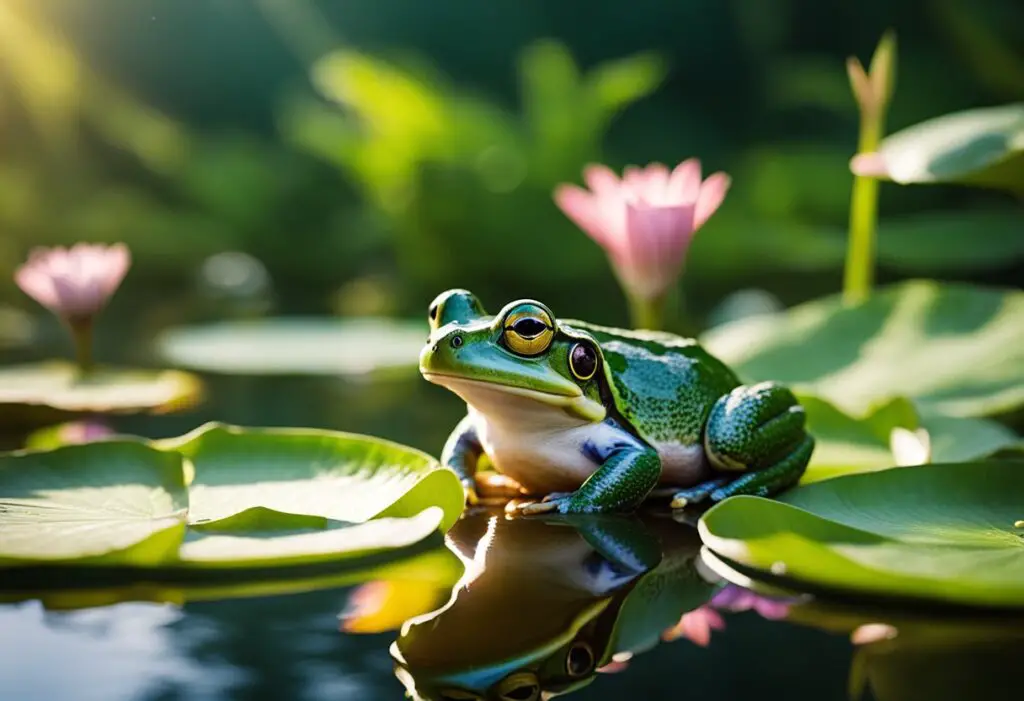
Take the American Bullfrog, for example, known to croak its way through 8 to 10 years in its natural habitat, they can stretch their life expectancy up to an impressive 16 years under human care. Northern Leopard Frogs bring their own spin to the longevity game, averaging 4 to 5 years in the wild, with the possibility of hopping on up to 9 years in captivity. These lifespans can be influenced by myriad factors such as diet, predation, and environmental stressors that shape the world of these charming amphibians.
Key Takeaways
- Frogs’ lifespans vary significantly by species, with an average range between 2 to 10 years in the wild.
- Captivity can extend a frog’s life, with some species living up to 16 years under human care.
- Factors like species, habitat conditions, and threats impact the overall longevity of frogs.
Frog Lifespan Basics
Frogs have quite the range when it comes to their lifespan, and you might be surprised to find out just how long these hoppy creatures can live under different circumstances. Let’s jump right in!
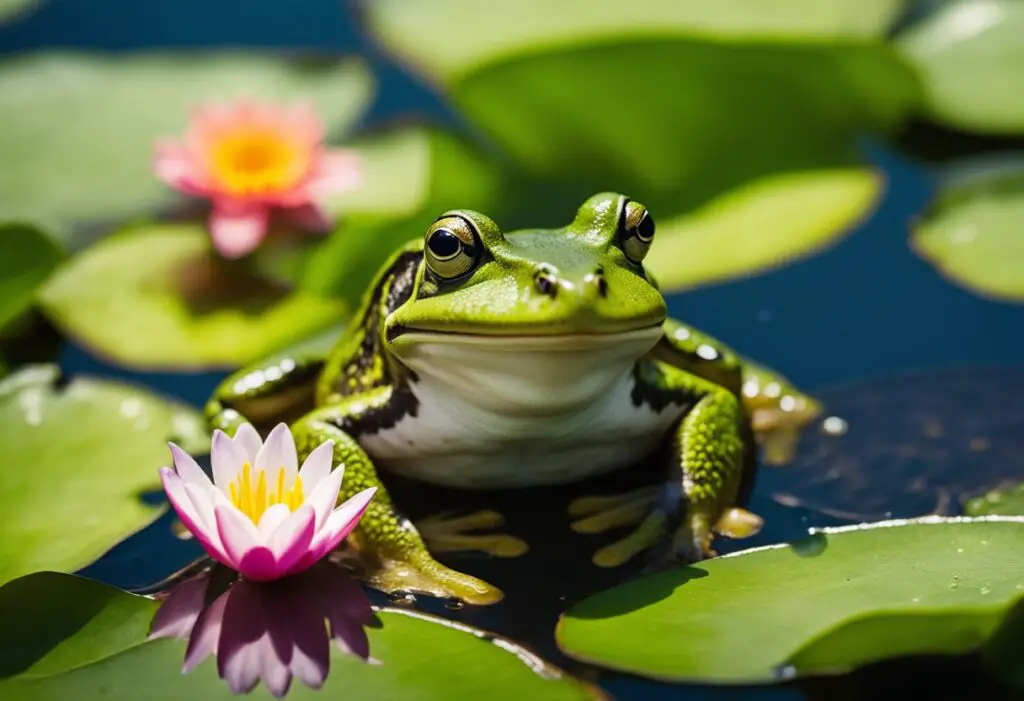
Average Lifespan in Wild and Captivity
Wild Frogs:
In the wild, frogs face a pond-full of challenges, from predators to environmental stresses. On average, these resilient creatures can live between 1 to 12 years depending on the species.
Captive Frogs:
However, in the humidity-controlled comfort of captivity, their lives can leap to astonishing lengths. Frogs in captivity generally outlive their wild cousins, boasting lifespans of 4 to 40 years for some species, like the Cane Toad who can croak out four fabulous decades.
Factors Influencing Lifespan
Size and Species:
Life expectancy isn’t a one-size-fits-all. Larger species typically live longer than their smaller counterparts.
Diet and Environment:
What you eat and where you live really do matter, even for frogs! Adequate food and a quality environment are akin to the fountain of youth for these guys.
Frog Development Stages
Did you ever wonder about the journey a frog takes from being a mere blob in a pond to becoming the hopping creature that you might spot in your garden? The transformation is nothing short of spectacular!
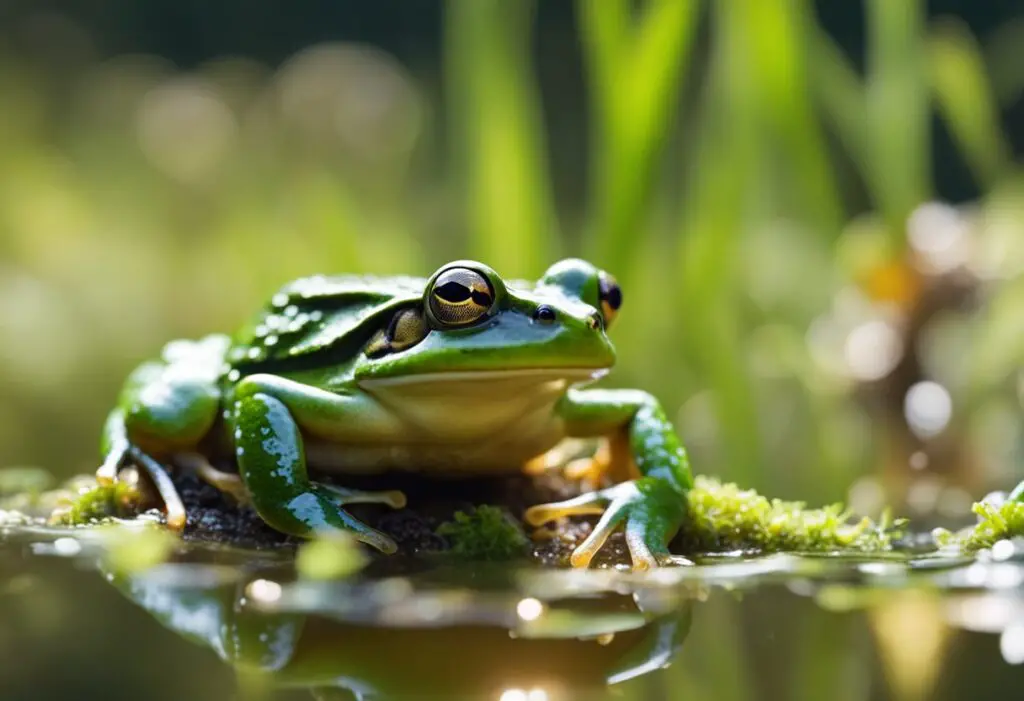
Tadpole to Adult Transition
When you look at a tadpole, you’re witnessing the start of a fascinating trip! As the tadpole stage progresses, these little fellows begin a series of physical changes.
- Weeks 1-3: At first, they’re mostly a mouth and a tail, and they stick around their birthplace as they absorb nutrients from the remnants of their egg’s yolk.
- Weeks 4-8: Gradually, they start to snack on algae, gaining strength and growing while their gills keep them breathing underwater.
- Weeks 9-12: Tadpoles then sprout back legs, followed by front legs, while their tails shrink and their diet transitions from herbivore to carnivore. Your garden’s future insect control is nearly in place!
Metamorphosis
This term might make you think of a magician’s spell, but it’s actually nature’s incredible transformation process.
- Larval Stage: Here, while still in tadpole form, lungs begin to develop, preparing them for life out of water.
- Climbing Out: With developed legs, tadpoles start to venture onto land. It’s like their first leap of faith into adulthood.
- Tail Resorption: Now, here’s a shocking bit – their tails get absorbed into their bodies. Yep, no tail waste here; it’s all about efficiency!
- Mature Adult: By 16 weeks, give or take, depending on species and climate, an adult frog emerges. It’s now a master of both land and water, ready to live for about 10-12 years in the wild.
With each ribbit and leap, frogs are a testament to the resilience and adaptability of nature. Just think, all adult frogs once made that monumental climb from water to land, just as the tadpoles in your local pond will do. Quite the leap of evolution, isn’t it?
Diversity of Frog Species
From tiny peepers to giants that defy the imagination, the frog family is a tapestry of species, each with their own unique lifestyles and life expectancies.
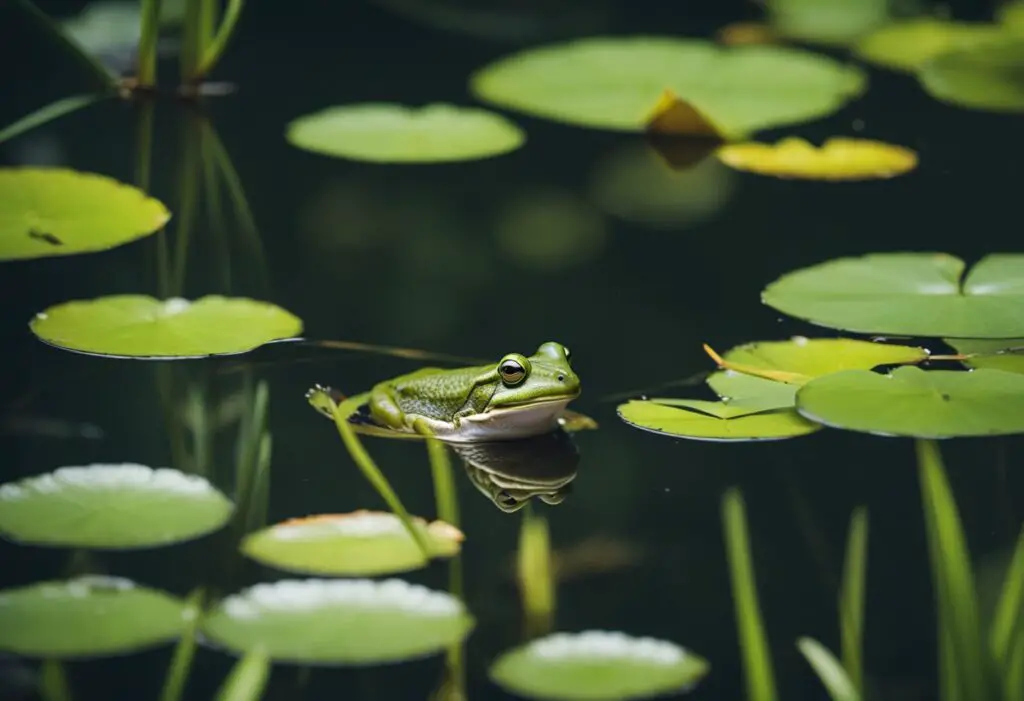
Common Species and Their Lifespans
American Green Tree Frog (Hyla cinerea): Lounging in the southeastern United States, your garden might be a home to these vibrant crooners which typically live around 6 years in the wild.
Common Frog (Rana temporaria): Found across Europe, these familiar hoppers enjoy a life expectancy of up to 10 years when they’re hopping around ponds and gardens.
Bullfrog (Lithobates catesbeianus): One of the largest and perhaps the most vocal, these fellows can live 7 to 10 years in the wild and up to 16 years in captivity.
Leopard Frog (Lithobates pipiens): Sporting snazzy patterns, these spotted friends often live 2 to 4 years in the wild, although some can jump their way to a ripe old age of 9 years.
Cane Toad (Rhinella marina): Imported toads gone wild, they can live a whopping 10 to 15 years and have even been recorded up to 40 years in captivity!
Wood Frog (Lithobates sylvaticus): With a cool ability to freeze and thaw with their habitat, these survival experts live between 3 to 8 years.
Rare and Exotic Species
If you’re curious about the more unusual suspects:
Goliath Frog (Conraua goliath): The heavyweight champion of the frog world, this African giant is as rare as it is big and has been noted to live up to 15 years if it manages to avoid predators and habitat loss.
Red-eyed Tree Frog (Agalychnis callidryas): A jewel of the tropics, these stunning creatures grace rainforests and, despite their flashy looks, have a surprisingly average lifespan of around 5 years.
Spring Peeper (Pseudacris crucifer): Though they might not boast exotic origins, their elusive nature makes them quite the rare sight. They serenade for 3 to 4 years in wild choruses.
Frog Habitats and Adaptation
Ever wondered how frogs can thrive in such a wide variety of environments around the planet? It’s all about their amazing adaptations and the habitats they call home. Let’s hop in and find out how they do it!
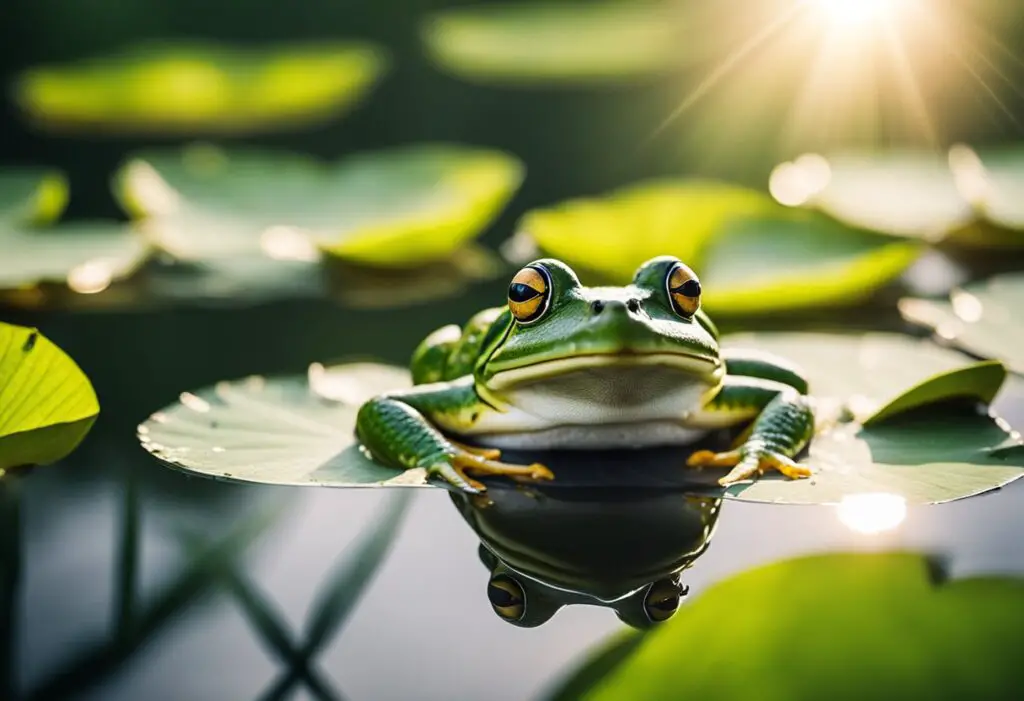
Aquatic vs. Terrestrial Environments
Frogs make their homes across a mind-boggling array of environments. Do you fancy a dip or prefer to stay dry? Well, frogs can choose! Aquatic frogs, as the name implies, live in places like lakes, ponds, and streams. Their webbed feet? Perfect for an afternoon swim. Terrestrial varieties, on the other hand, make the land their stage with habitats ranging from treetops to underground burrows. Oh, and they enjoy a good moisture level too — it’s crucial for their skin to stay hydrated and for the survival of their offspring during the tadpole phase.
- Aquatic Habitats: These include still waters or running streams.
- Adaptation: Fully webbed feet for swift swimming.
- Terrestrial Habitats: Varies from lush forests to arid deserts.
- Adaptation: Cushioned pads for gripping and hopping.
Adaptations for Survival
Think of adaptations as frogs’ superpowers; they’re tailored features that help our amphibian friends survive. Camouflage? Check. Your local frog can blend into its surroundings like a pro, avoiding predators with ease. And look at those powerful legs, allowing for escape in great bounds. In some species, like the flying frogs, webbing between their fingers and toes helps them glide gracefully through the air — talk about an upgrade on your average hop!
- Physiological: Deep in hibernation during extreme weather.
- Behavioral: Mating calls to serenade in the night.
Remember, these habitat choices and adaptations don’t just make them some of the most versatile creatures; they’re crucial for their survival, helping maintain moisture levels in various climates and offering protection against the buffet of dangers in the wild. So the next time you spot a frog, take a moment to appreciate its unique lifestyle and survival skills!
Diet and Predation
Hey there, curious reader! Ever wondered what keeps frogs hopping along in life? It’s all about chowing down and steering clear of becoming someone else’s snack. Let’s munch into the details—insects beware!
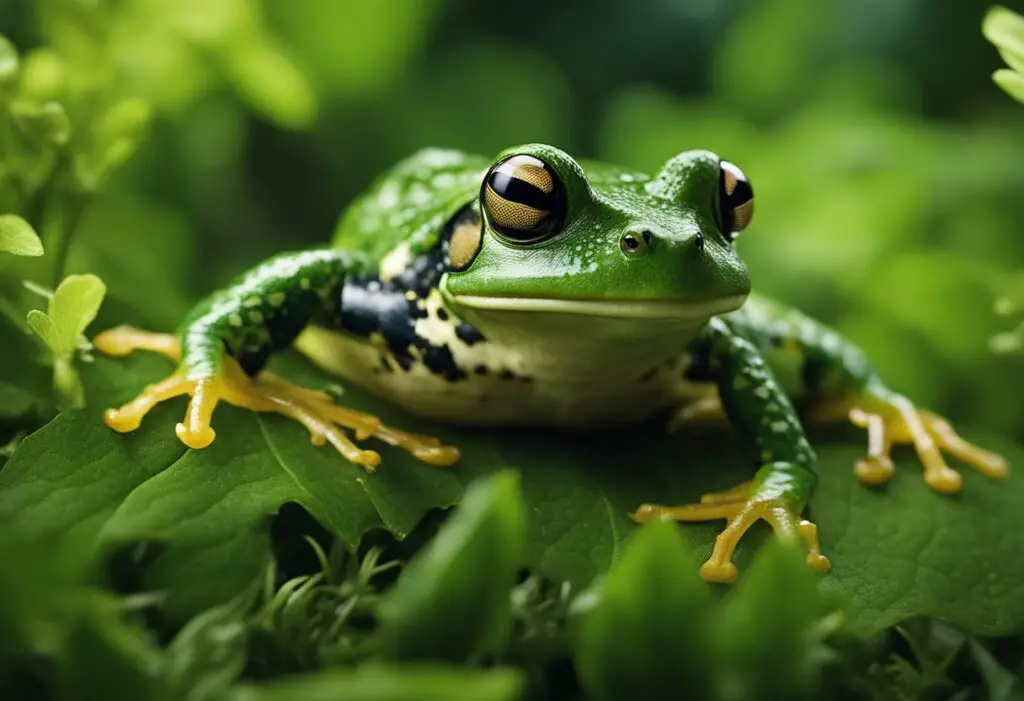
What Frogs Eat
Frogs are not picky eaters, and their diet is a smorgasbord of creepy crawlies. For starters, they have a big appetite for:
- Insects (think flies, mosquitoes, and moths)
- Small invertebrates
- Algae (for the vegetarian tadpoles out there)
Imagine sitting on a lily pad and snagging a flying buffet. That’s a frog’s dream dinner!
Natural Predators of Frogs
We’ve got to talk about the flip side: the natural predators. Frogs must always be on the lookout for:
- Snakes slithering by for a froggy feast
- Birds swooping down for a quick bite
- Larger amphibians who don’t mind a bit of frog in their diet
With such a diverse menu and equally varied list of predators, life as a frog is a delicate balance between feasting and fleeing. Stay alert, little hoppers!
Reproduction and Growth
When you think about frogs, what comes to mind regarding their beginnings? It’s an incredible journey from a single egg to a fully grown frog—and it all starts when frogs feel the warmth of the breeding season.
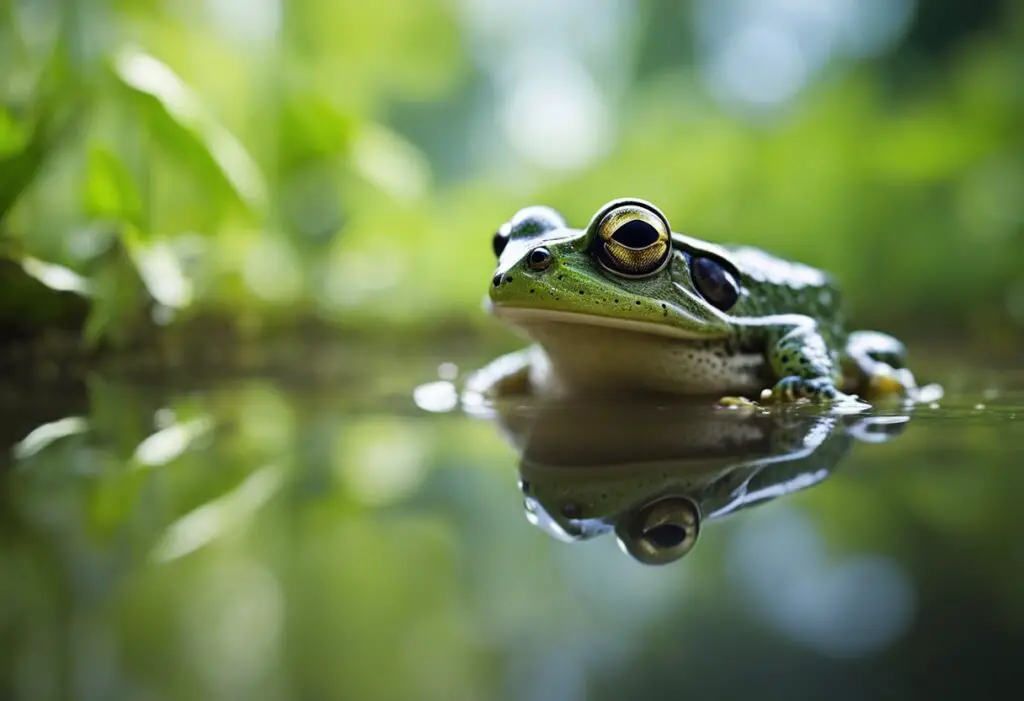
Breeding Habits
Ever been to a pond during spring and heard a chorus of croaks? Well, mate, that’s a frog party in full swing! Breeding season is a busy time for frogs. Most species are ready to mingle once they hit one year, but not before showing off to find the perfect mate. During amplexus, which is a fancy word for froggy hug, the male clings to the female to fertilize the eggs as she lays them. It’s kind of their way to ensure their lineage continues.
- Mating onset: Typically occurs in spring
- Amplexus: Male grips the female to fertilize eggs
Growth after Hatching
Alright, let’s hatch some details about what happens post-spawn! When the eggs hatch, tiny vegetarians called tadpoles emerge, ready to grow into the adult carnivores we’re more familiar with. It’s a tough world for these little squirts—only a puny percentage make it to adulthood. Checkout the quick lowdown:
- Eggs: Clusters or strings laid in water
- Growth: From vegetarian tadpole to carnivorous frog
- Hatching to frog: Can vary from mere days to weeks, depending on the species
Remember, this whole process is a race against time and dangers, with each stage presenting new challenges for survival.
Threats to Frog Populations
When it comes to the survival of frogs, several factors tip the scale against our jumpy friends. You might be surprised to learn how much of their plight relates to our choices and the environment.
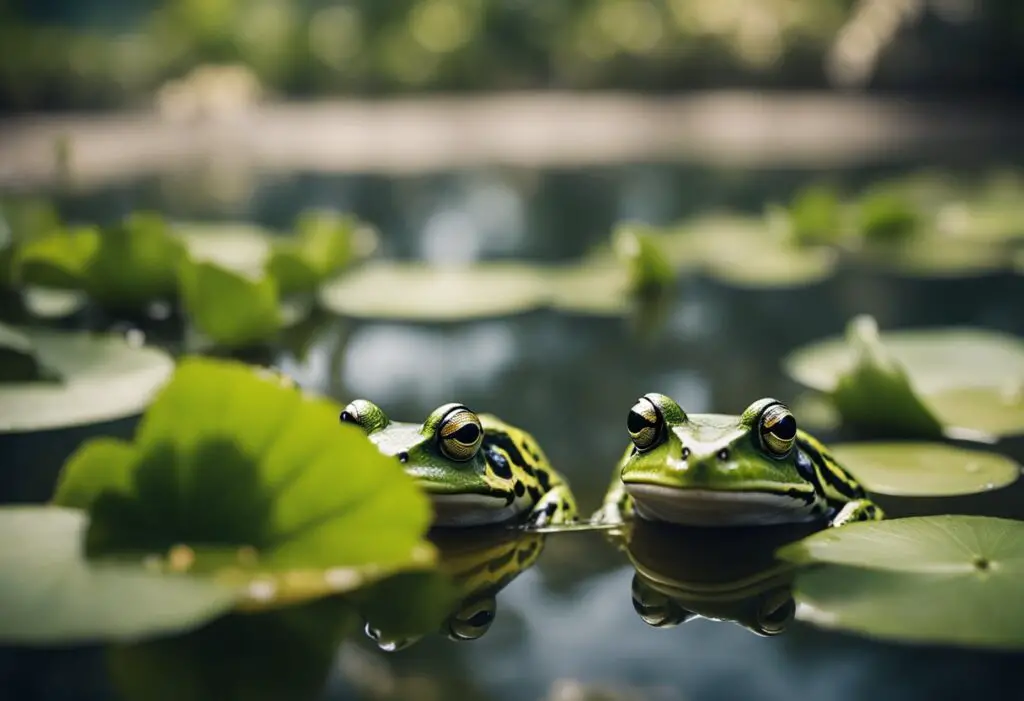
Environmental Challenges
Environmental challenges come in many shapes and sizes, but for frogs, it’s particularly harsh. Let’s unpack this:
- Predators: It’s a frog-eat-frog world out there! Natural predators are always a threat, but it’s the circle of life, right?
- Habitat Loss: Frogs love their ponds and wetlands. However, due to various reasons like urban sprawl, agriculture, and deforestation, their homes are vanishing faster than a fly at a frog party. Cause Effect Deforestation Loss of forest habitat Urbanization Destruction of wetlands Agriculture Draining of water bodies
- Diseases: Such challenges include the notorious chytrid fungus, which contributes to endangered species and risks of extinction.
Human Impact on Frog Lifespan
You might wonder, “What does my lifestyle have to do with frogs?” Quite a bit, actually:
- Pollution: Every time pollutants enter waterways, frogs are at risk. They are like the canaries in the coal mine for ecosystems.
- Chemical runoff from agriculture
- Plastic waste
- Industrial pollutants
- Human Activity:
- Climate Change: Frogs are sensitive to temperature changes, and climate change, driven by human actions, plays havoc on their life cycles.
- Introduced Species: That includes troublesome species like the cane toad, which competes with native frogs for resources.
- Conservation Status: It’s a silver lining that we are aware of the situation. Laws and regulations aimed at protecting these critters are in place in many regions.
Conservation and Protection
Ensuring the longevity of frog species isn’t just about understanding their lifespans, but also about the vital conservation and protection efforts that go into keeping their ribbits a part of our world. Let’s hop into what’s being done to safeguard these amazing amphibians.
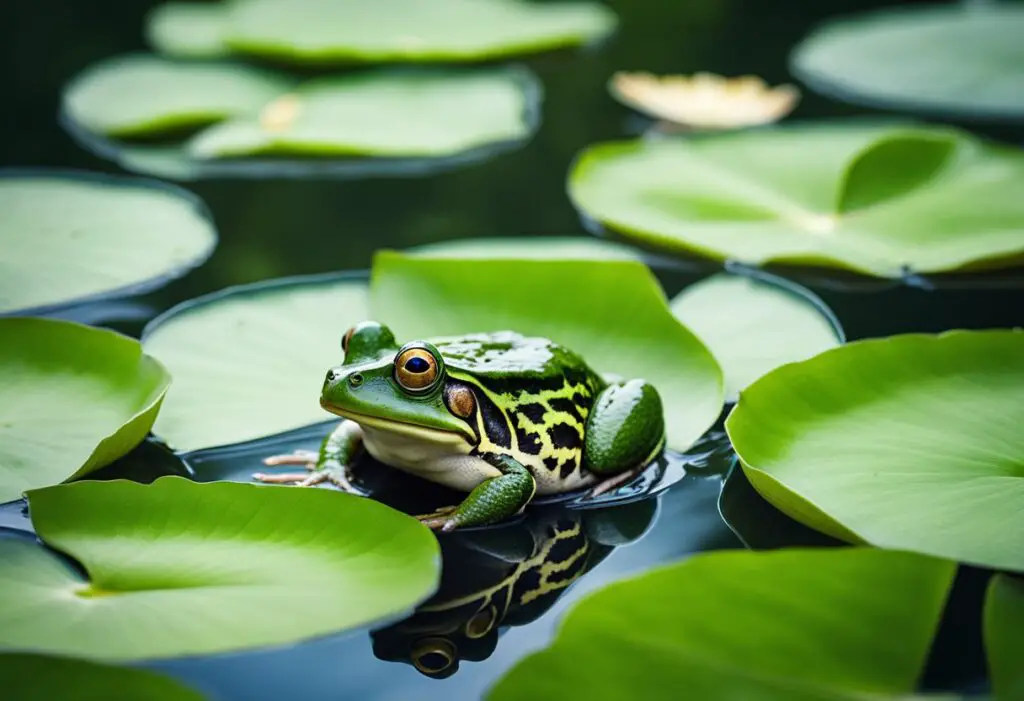
Conservation Efforts for Frog Species
Imagine you’re a frog for a second – your home is as important as your lily pad, right? To make sure frogs can leap into the future, conservationists worldwide are actively working to preserve their natural habitats. Protection of wetlands and regulation of pollutants are pivotal in this mission, reducing threats such as habitat destruction and toxic substances that can harm frogs. International agreements and local laws can provide a legal safety net for these habitats and are often established based on the conservation status of frog species, which can range from least concern to critically endangered.
- Case Study: In areas where the Green and Black Poison Dart Frog resides, efforts include protecting the tropical rainforests of Central and South America.
- Statistics: The Argentine Horned Frog, with a varying lifespan of 5 to 12 years, benefits from conservation measures in its South American range to maintain its population.
Captive Breeding Programs
Captive breeding programs are like speed dating for frogs – they’re a helping hand in the romance department to ensure future generations. Zoos and conservation centers take the lead by creating ideal conditions for frogs to breed, mimicking their natural environments. This not only helps to bolster numbers for declining species but also provides opportunities for research and education.
- Highlight: One success story is the increase in populations of certain species due to well-managed captive breeding efforts.
- Note: These programs are critical for species with alarming conservation statuses, like those facing imminent threats in the wild.
By participating in or supporting these efforts, you’re becoming a superhero for frogs! Keep that in mind the next time you hear the distant chorus of croaks – those sounds are here thanks to efforts like these, and perhaps, a little thanks to you too.
Conclusion
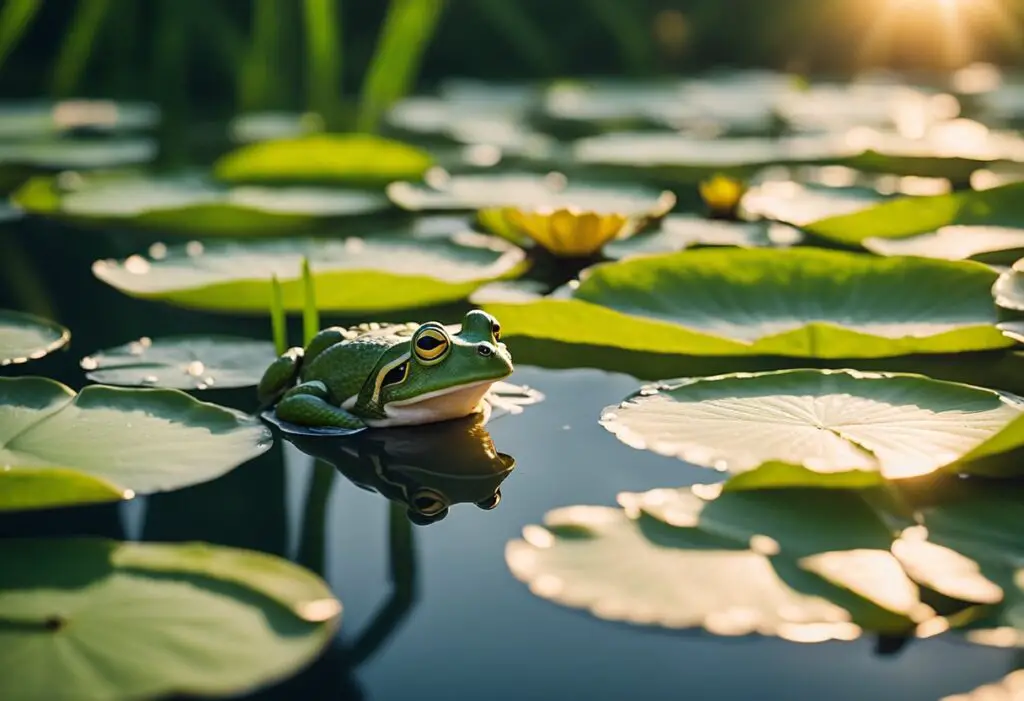
Did you know that your little amphibian friend could potentially be a long-term companion? It’s true! Frogs, those jump-happy critters we often see after a rain shower, have varying lifespans based on their species and whether they’re chillin’ in your backyard pond or the controlled environment of a terrarium.
Here’s a quick jump into the numbers:
- In the wild: A frog’s life can be a hop in the park or a survival saga, typically ranging from 1 to 12 years.
- In captivity: Some frogs can age gracefully up to 40 years—imagine that!
Frequently Asked Questions
Let’s hop right into the common curiosities about our web-footed friends! You’ll find some surprising feats of longevity and hardiness that may change the way you think about these fascinating amphibians.
What is the typical lifespan of frogs when they live in their natural habitat outside?
Out in the wild, your average frog lives for about 1 to 12 years, grappling with the full kaleidoscope of outdoor challenges. This varies hugely between species and environmental conditions.
If kept indoors, how long can we generally expect a frog to live?
When you bring a frog indoors to a cozy terrarium with constant food and no predators, they can kick back and enjoy a lifespan of 4 to 40 years, depending on their species and care.
Under normal circumstances, how long can frogs survive without eating?
It’s a wild world out there, and sometimes a frog has to rough it. Normally, a frog could go weeks without a meal, but it isn’t a fun time for them—think grumbling stomachs but no pizza delivery.
Without access to water, what’s the survival time frame for a frog?
Frogs need to keep their skin moisturized, so without water, they’re in a bind. They can survive a few days, tops. Always keep those splash zones ready for your amphibious pals.
Can you tell me about the longevity of tree frogs specifically?
Tree frogs are the acrobats of the amphibian world, and they are known to live about 16 years on average. Some species can outlive this estimate in the right conditions.
Is it true that some frogs can reach the ripe age of 40, and if so, which species are known for longer lifespans?
Absolutely! Some frog species like the European Common Toad can live up to 40 years if they’re kept safe from predators and diseases, especially in captivity. It’s a monumental milestone for such small creatures!

